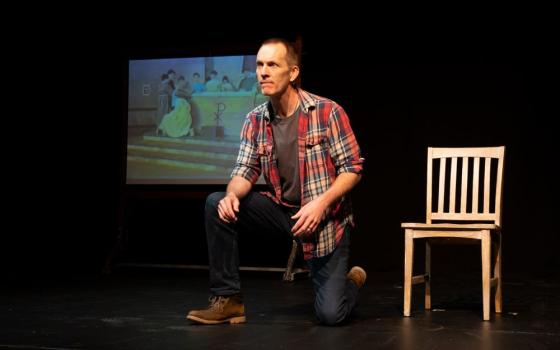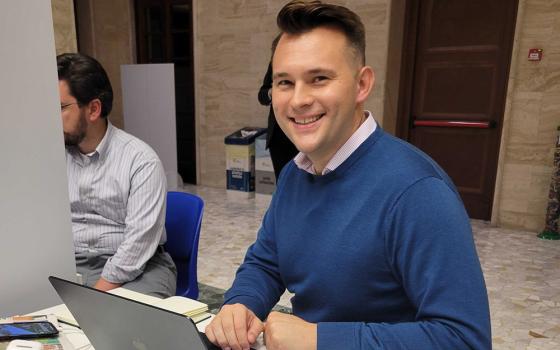
Legendary pitcher Mitch “Wild Thing” Williams, who threw for six teams during his pro career, recently described the difference between playing on the West Coast and the East Coast during a segment on the brand new MLB Network.
“In L.A., if the Dodgers are losing in the seventh inning, people just go home and watch the end of the game on TV,” Williams said. “In New York or Philly, if you’re losing in the seventh inning, they go home, get the TV, come back to the ballpark and throw it at you.”
In a word, Williams said, the difference is “intensity.”
In reality, it’s not just sports where things are amped up back East. Church leaders, too, play on a much bigger stage, facing greater scrutiny from the press and higher expectations of national leadership. They also preside over flocks which are often more unruly, and more vocal when they’re unhappy.
Nowhere is that high-octane atmosphere more pronounced than the Big Apple, which means that Archbishop Timothy Dolan, announced at the Vatican and in Washington Feb. 23, as the 13th archbishop of New York, is stepping into the biggest pressure-cooker in American Catholicism.
Dolan, 59, was born in St. Louis in 1950. A former rector of the North American College in Rome and a former auxiliary bishop in St. Louis, he has served as archbishop of Milwaukee since 2002.
By most accounts, Dolan inherits New York from a leader, Cardinal Edward Egan, who never quite felt at home. Egan’s nine-year tenure was marked by a series of unpopular choices, including closing schools, transferring priests and clustering parishes. While many observers say these steps were essential to put the church on a more sound fiscal and administrative footing, critics charge they were sometimes developed without adequate consultation. In their wake, whether fairly or unfairly, Egan acquired a reputation as aloof, isolated, and authoritarian.
(A 2007 episode was symbolic, in which the pastor of a Lithuanian parish in lower Manhattan slated for closing was summoned to an impromptu meeting with the cardinal, and while he was away, security guards dispatched by Egan changed the locks to the church. The New York Post’s front-page coverage was headlined, “Cardinal Sin!”)
In the end, Egan was never able to wield the “bully pulpit” of New York like his legendary predecessor Cardinal John O’Connor. In the immediate aftermath of 9/11, Egan hesitated to return from a synod of bishops in Rome and generally ceded the stage to former Mayor Rudy Giuliani, creating a vacuum in the archbishop’s public standing from which he never seemed able to recover.
In naming Dolan to the post, Pope Benedict XVI is clearly hoping to turn that around.
---------------------------------------------------------------------------------------------------------------------------------------------------------------------------------------------------------
Read also: Dolan appointment fits pattern in Benedict's U.S. episcopal appointments
---------------------------------------------------------------------------------------------------------------------------------------------------------------------------------------------------------
Dolan shares Egan’s loyalty to Rome and his generally conservative outlook, but in most other ways he’s a study in contrasts. Dolan is endlessly gregarious and self-deprecating; for example, when asked the difference between his ordination to the priesthood and his ordination as an auxiliary bishop of St. Louis 25 years later, the portly Dolan quipped, “about 50 pounds.” He’s also obviously comfortable with the press, a trait that runs in the family; his brother Bob was a popular AM radio talk show host for many years in Milwaukee.
In some ways, observers say that Dolan could be seen as a throwback to the best of pre-Vatican II American Catholicism: rock-solid in his orthodoxy, unapologetic about his loyalty to the papacy and to Rome, yet quintessentially American in his optimism, his practicality and lively sense of humor, with a clear priority on fostering good priests and good parishes.
Where Egan tended to concentrate on the nuts and bolts of internal ecclesiastical administration, Dolan also has an appetite for engaging the wider world. He’s the author of three popular books on the priesthood and Catholic spirituality, offering practical spiritual guidance that draws on eclectic sources such as self-help guru Steven Covey, the late President Ronald Reagan, and the late Belgian Cardinal Désiré Mercier. By reputation, Dolan is also a prelate who prefers to be out in the field rather than behind a desk, spending time in parishes, rectories, seminaries and hospitals.
On a Myers-Briggs test, Dolan’s scores for “extrovert,” according to most observers, would be off the chart.
Born in St. Louis, Missouri, in 1950, Dolan obtained a doctorate in American church history from the Catholic University of America in the early 1980s. (His dissertation focused on Archbishop Edwin O’Hara, a founder of the Catholic Biblical Association.) He was a parish priest in St. Louis from 1983-87, but it seemed obvious even then that Dolan was marked for higher office; in 1987, that was confirmed when he was named a secretary to the papal nuncio, or ambassador, in Washington.
After a brief stint at Kenrick-Glennon Seminary in the early 1990s, he went to Rome to serve as rector of the North American College, the American seminary in Rome. Students who knew Dolan in those days say he was a no-nonsense leader, but that his good cheer leavened what can sometimes be a stuffy and formal environment.
“He ran a happy house,” said Fr. Raymond de Souza, a former seminarian at the NAC who today is a pastor and well-known columnist in Canada.
In June 2001, Dolan was named an auxiliary bishop in St. Louis, where then-Archbishop Justin Rigali, today the cardinal of Philadelphia, gave him special responsibility for vocations. Dolan’s connection with Rigali would prove decisive for his rapid rise, as Rigali is a former official in the Vatican’s Secretary of State and today sits on the Congregation for Bishops, the all-important body in Rome that vets episcopal nominations.
In August 2002, Dolan succeeded Archbishop Rembert Weakland in Milwaukee. The assignment was seen as a test of Dolan’s mettle, given that as he arrived, the archdiocese was in the grip of a crisis triggered by revelations that Weakland had secretly used $450,000 in church money to reach a settlement with a man who accused him of sexual abuse. (Weakland acknowledged a sexual relationship, but denied there had been abuse.) Moreover, Weakland was known as a leader of the liberal wing of American Catholicism, while Dolan leans more to the right. Some in Milwaukee worried that Dolan had been sent to bring the archdiocese to heel.
Publicly, Dolan was a quick hit, using humor to defuse tensions. During his installation Mass, for example, he noted that eight cardinals were in attendance, and quipped: “One more and we could field a baseball team … which, considering how the Brewers are playing, might not be such a bad idea.” (The Brewers finished 56-106 in 2002, last in the National League Central.)
On matters of substance, Dolan pledged greater financial accountability, and followed through by hiring an independent auditing firm and mailing their results to every Catholic household in the 10-county archdiocese. He held an emotional series of meetings with victims, and set up an independent mediation process to settle claims that reduced the role of lawyers. That process played to mixed reviews, as some victims’ groups felt Dolan was stacking the deck against people with legitimate grievances.
Dolan indeed struck a more conservative tone than Weakland – for instance, he insisted on following the church’s rules on liturgy more closely – but on most hot-button questions he never veered far from the center. For example, Dolan expressed admiration for bishops such as Raymond Burke who threatened to deny communion to pro-choice politicians, but never took that step himself. When the Vatican issued a document barring gays from the priesthood in 2005, Dolan adopted what would come to be seen as the “moderate” reading – that men with same-sex inclinations could be ordained as long as they were capable of celibacy and not part of a “gay subculture.”
“It’s not a no-gays policy,” Dolan said on CNN.
Though Dolan was a PR success, things did not get off to an auspicious start with his priests. During their first meeting, Dolan delivered a spiritual reflection on what it means for a priest to stand in persona Christi, “in the place of Christ.” Some priests felt Dolan was being pietistic, and peppered him with more practical questions such as his plans for salaries and whether he planned to reverse Weakland’s policy allowing priests to live in private apartments rather than rectories. Dolan, in turn, felt that some of the priests had lost their spiritual “fire in the belly,” and seemed consumed by secondary matters.
Over time, Dolan earned grudging credit for being a capable manager, a good listener, and having a strong pastoral streak, even if some of his theological convictions remain a tough sell for priests more accustomed to Weakland’s almost 25-year tenure.
Among his brother bishops, Dolan likewise draws high marks as a person and a public figure, but some locate him a bit to the right of the conference’s mainstream. In November 2007, Dolan lost a race to become vice-president of the conference to Bishop Gerald Kicanas of Tucson, a moderate in the tradition of the late Cardinal Joseph Bernardin of Chicago, by a margin of 55-45 percent.
On the other hand, Dolan is by no means seen as an ideologue. He serves as the chair of Catholic Relief Services, the major overseas relief agency of the U.S. church, and when CRS came under fire in 2008 for allegedly promoting condoms as part of anti-AIDS efforts, Dolan came to its defense. He issued a letter to the effect that CRS materials were “fully in keeping” with church teaching. Dolan has also taken an interest in Jewish/Catholic relations, traveling to Auschwitz and playing a behind-the-scenes role during moments of crisis in reaching out to Jewish leaders.
In the run-up to his appointment, the major drawback cited in terms of Dolan’s candidacy for New York is that he has no ties to the area. That was true of Egan as well, and perceptions that Egan had been imposed on New York by the late Pope John Paul II – against O’Connor’s wishes – created resentment that proved hard to shake. Moreover, some say that New York is so big and complex that an archbishop who doesn’t already know the score starts with a major handicap.
“He’ll spend his first ten years just trying to figure out who he can trust,” a fellow archbishop said, speaking on background.
On the other hand, some say that being an outsider could actually work in Dolan’s favor, since he won’t bring any baggage to the job as a result of being identified with one party or the other on the local scene. Moreover, Dolan does have one bit of biography that makes him a good fit: Like every previous archbishop of New York save one, he’s of Irish descent.
In any event, most people seem to believe that Dolan’s sunny, outgoing persona will strike New York as a breath of fresh air.
Fr. David O’Connell, president of the Catholic University of America, put it this way: “If the part of archbishop of New York could ever be scripted,” O’Connell said, “Dolan would really be cast in that role.”
John L. Allen Jr. is NCR’s Senior Correspondent. His e-mail address is jallen@ncronline.org.




